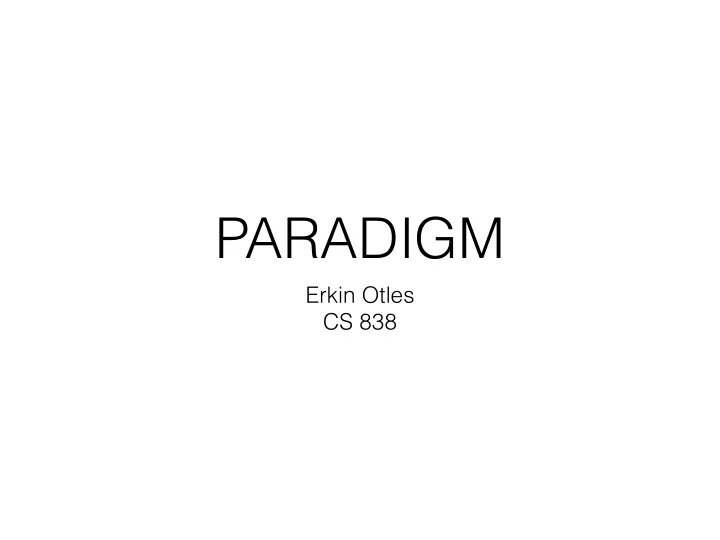

PARADIGM Erkin Otles CS 838
PARADIGM Approach We developed an approach called PARADIGM (PAthway Recognition Algorithm using Data Integration on Genomic Models) to infer the activities of genetic pathways from integrated patient data. Multiple genome-scale measurements on a single patient sample are combined to infer the activities of genes, products and abstract process inputs and outputs for a single NCI pathway.
PARADIGM Approach PARADIGM produces a matrix of integrated pathway activities (IPAs) A where Aij represents the inferred activity of entity i in patient sample j.
Method
GOAL! Make a factor graph that represents the underlying pathway. Each entity can take on one of three states corresponding to activated, nominal or deactivated relative to a control level (e.g. as measured in normal tissue) and encoded as 1, 0 or − 1 respectively. The states may be interpreted differently depending on the type of entity (e.g. gene, protein, etc)
Factor Graph Goal The factor graph encodes the state of a cell using a random variable for each entity X={x1, x2,…, xn} and a set of m non-negative functions, or factors, that constrain the entities to take on biologically meaningful values as functions of one another. The j-th factor ϕ j defines a probability distribution over a subset of entities x_j ⊂ X. The entire graph of entities and factors encodes the joint probability distribution over all of the entities as: where Z= ∏ j ∑ S ⊏ Xj ϕ j(S) is a normalization constant and S ⊏ X denotes that S is a ‘setting’ of the variables in X.
Construction In order to simplify the construction of factors, we first convert the pathway into a directed graph, with each edge in the graph labeled with either positive or negative influence. Every interaction in the pathway is converted to a single edge in the directed graph. Using this directed graph, we then construct a list of factors to specify the factor graph. For every variable xi, we add a single factor ϕ (Xi), where Xi={xi} ∪ {Parents(xi)} and Parents(xi) refers to all the parents of xi in the directed graph.
Filling Out the FG The expected value was set to the majority vote of the parent variables. If a parent is connected by a positive edge it contributes a vote of +1 times its own state to the value of the factor. (negative edge, then − 1) The variables connected to xi by an edge labeled ‘minimum’ get a single vote, and that vote's value is the minimum value of these variables, creating an AND-like connection. Similarly the variables connected to xi by an edge labeled ‘maximum’ get a single vote, and that vote's value is the maximum value of these variables, creating an OR-like connection. Votes of zero are treated as abstained votes. If there are no votes the expected state is zero. Otherwise, the majority vote is the expected state, and a tie between 1 and − 1 results in an expected state of − 1 to give more importance to repressors and deletions.
Inference Given patient data, we would like to estimate whether a particular hidden entity xi is likely to be in state a. For example, how likely TP53's protein activity is − 1 (inactivated) or ‘Apoptosis’ is+1 (activated). To do this, we first compute the prior probability of the event prior to observing the patient's data. If Ai(a) represents the singleton assignment set {xi=a} and Φ is the fully specified factor graph, this prior probability is:
Inference Cont. The probability that xi is in state a along with all of the observations made for the patient is: For the majority of pathways, we use the junction tree inference algorithm with HUGIN updates to infer the probabilities in equations. For pathways that take longer than 3 s of inference per patient, we use Belief Propagation with sequential updates. To learn the parameters of the observation factors we use the expectation-maximization (EM) algorithm.
How to Make IPAs After inference, we output an IPA for each variable that has an ‘active’ molecular type. We compute a log-likelihood ratio using the quantities: We then compute a single IPA for gene i based on the log-likelihood ratio as:
Aside: Factor Graphs
Draw Factor Graph
Too Tired to Merge These Slides http://www.cedar.buffalo.edu/~srihari/CSE574/Chap8/ Ch8-GraphicalModelInference/Ch8.3.2- FactorGraphs.pdf http://disi.unitn.it/~passerini/teaching/2010-2011/ MachineLearning/slides/09_inference_in_bn/talk.pdf http://www.cs.cmu.edu/~sandholm/cs15-780S11/ slides/19-factor-graphs-mc.pdf
Results
Future Work
Recommend
More recommend